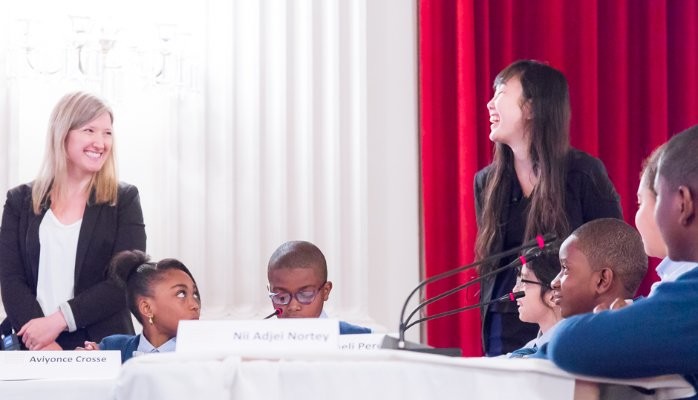
I Taught Math on Capitol Hill. Here’s How it Went
A few weeks ago, I traveled down to Washington, D.C., with five other Success Academy educators and ten fifth graders to deliver a math lesson on Capitol Hill. Actually, it was more than just a math lesson — it was a demonstration of just how effective great teaching can be.
We wanted to peel back the curtain to show exactly how Success Academy teachers get outstanding achievement results for an inner-city student body made up predominantly of low-income minority children. Last year, 94% of our students passed New York's proficiency exams, compared with 36% of students across the state.
Uniquely, the demonstration didn’t start with the classroom or the students — but in a planning session where math teacher Dana Adnopoz, her principal, Lisa Sun, and math specialist Beth Zhang met to plot through and strategize Dana’s approach to the day’s lesson.
The fifth graders from Success Academy Harlem North Central middle school had to solve the following problem: Which is the better deal, 12 cans of pet food for $15 or 20 cans for $23? Dana’s challenge was to create a sequence of questions and conditions that would allow students to find their own path to understanding.
Once the scholars filed into the large caucus room and took their places in a makeshift classroom before an audience of 150 educators and policymakers, “class” began. Dana asked one student to explain the approach she had used to arrive at an (incorrect) solution. At Success Academy, there is no shame in not knowing the answer; in fact, mistakes are welcome, because grappling with a problem is an important part of the learning process.
Other scholars shared their methods of solving the pet food problem and weighed in on whether each approach made sense, or whether there was a better way. Dana probed with questions, but the students did the actual teaching. At the same time, the principal asked some pointed questions of her own, coaching the teacher on how to push the scholars to a deeper understanding of the math.
Together, over the course of a half-hour, the children figured out three distinct strategies for arriving at the right answer. (For those of you who are wondering, 20 cans for $23 is the better buy.)
After class, the three educators debriefed on what had worked and what hadn’t — a critical part of Success Academy’s learning cycle. Not only do our principals provide in-the-moment feedback to teachers in the classroom, they also take the time to reflect: which students understood and which seemed to still not be grasping the concepts; what could be done better next time.
What our audience on Capitol Hill saw – students and teachers engaging in in-depth teaching and learning – is not something that happens often in the U.S., because the vast majority of teachers are poorly trained and ill prepared.
At Success Academy, we focus on mastering deep concepts rather than merely arriving at the “right” answer. Getting the correct answer is important, but taking the time to work through the problem, share different strategies, and debate the merits of each approach are critical to gaining a true understanding of math — and other subjects as well.
The work is rigorous, and we expect it of every one of our teachers. But we never expect them to go it alone. Our teachers spend up to six weeks of intensive training every summer at what we call T School. They also get 400 hours of professional development during the school year, studying content, observing master teachers, practicing their own teaching, receiving real-time feedback, and collaborating with colleagues.
We believe that teachers cannot be truly committed to educating children if they themselves are not actively studying and learning. If our students are to learn at the highest levels, our teachers must be prepared to teach at the highest levels.
This is a matter of national urgency, and the solutions are clear. This country needs to start emphasizing excellent teacher training and stop blaming the children for the failure of the adults. When adults are performing at the top of their game, kids will succeed.
Until we are able to staff our schools with greater numbers of strong, effective teachers, our education system will simply not be capable of turning out students who are equipped to compete in a global economy. Already, China and India are eating our lunch; if we don’t raise our game, they’re going to eat our dinner as well.
On Capitol Hill, our small army of educators and scholars showcased some of the most essential, powerful elements of teaching and learning. They proved that it can be done. Congress must make it a priority to see that it will be done.
Education Management Professional
7yAWESOME,
President at Robert DeFelice & Assoc.
8yWashington Math: 1+2=........lets make a deal.
Wild Card - draw me for a winning hand | Creative Problem Solver in Many Roles | Manual Software QA | Project Management | Business Analysis | Auditing | Accounting |
8ySo, will you teach the politicians on Capital Hill how to do math? They seem to be really bad at it :)
Maths
Process Improvement Specialist
8yThere are many examples of effective teaching. Unfortunately politics gets in the way and we can't seem to learn how to do a better job.